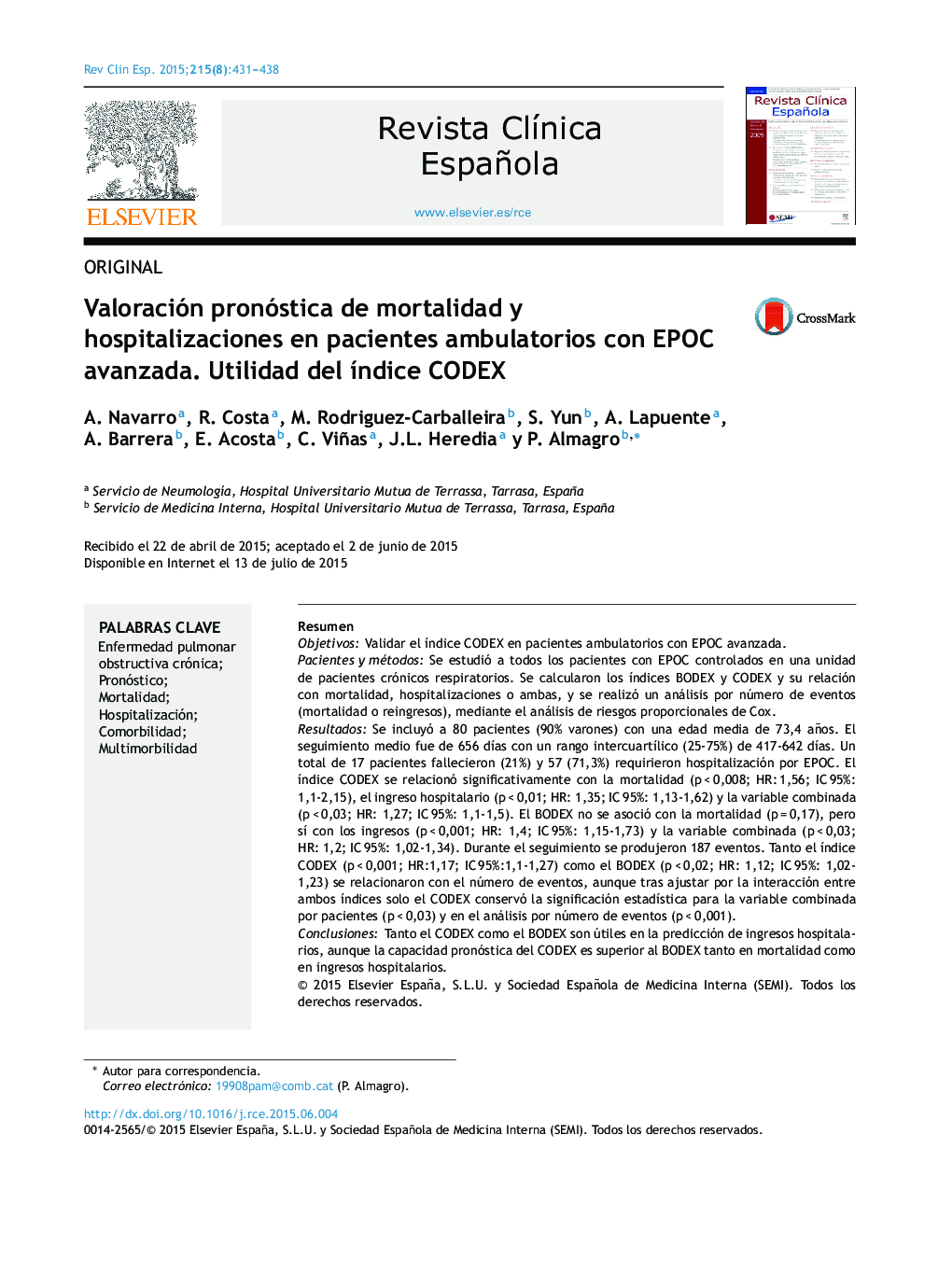| Article ID | Journal | Published Year | Pages | File Type |
|---|---|---|---|---|
| 3826953 | Revista Clínica Española | 2015 | 8 Pages |
ResumenObjetivosValidar el índice CODEX en pacientes ambulatorios con EPOC avanzada.Pacientes y métodosSe estudió a todos los pacientes con EPOC controlados en una unidad de pacientes crónicos respiratorios. Se calcularon los índices BODEX y CODEX y su relación con mortalidad, hospitalizaciones o ambas, y se realizó un análisis por número de eventos (mortalidad o reingresos), mediante el análisis de riesgos proporcionales de Cox.ResultadosSe incluyó a 80 pacientes (90% varones) con una edad media de 73,4 años. El seguimiento medio fue de 656 días con un rango intercuartílico (25-75%) de 417-642 días. Un total de 17 pacientes fallecieron (21%) y 57 (71,3%) requirieron hospitalización por EPOC. El índice CODEX se relacionó significativamente con la mortalidad (p < 0,008; HR: 1,56; IC 95%: 1,1-2,15), el ingreso hospitalario (p < 0,01; HR: 1,35; IC 95%: 1,13-1,62) y la variable combinada (p < 0,03; HR: 1,27; IC 95%: 1,1-1,5). El BODEX no se asoció con la mortalidad (p = 0,17), pero sí con los ingresos (p < 0,001; HR: 1,4; IC 95%: 1,15-1,73) y la variable combinada (p < 0,03; HR: 1,2; IC 95%: 1,02-1,34). Durante el seguimiento se produjeron 187 eventos. Tanto el índice CODEX (p < 0,001; HR:1,17; IC 95%:1,1-1,27) como el BODEX (p < 0,02; HR: 1,12; IC 95%: 1,02-1,23) se relacionaron con el número de eventos, aunque tras ajustar por la interacción entre ambos índices solo el CODEX conservó la significación estadística para la variable combinada por pacientes (p < 0,03) y en el análisis por número de eventos (p < 0,001).ConclusionesTanto el CODEX como el BODEX son útiles en la predicción de ingresos hospitalarios, aunque la capacidad pronóstica del CODEX es superior al BODEX tanto en mortalidad como en ingresos hospitalarios.
ObjectivesTo validate the CODEX index in outpatients with advanced chronic obstructive pulmonary disease (COPD).Patients and methodsWe studied all patients with COPD treated in a chronic respiratory disease unit. We calculated the BODEX and CODEX indices and their relationship with mortality, hospitalisations or both and performed an analysis by number of events (mortality and/or readmissions), using the Cox proportional hazards analysis.ResultsWe included 80 patients (90% men) with a mean age of 73.4 years. The mean follow-up was 656 days, with an interquartile range (25-75%) of 417-642 days. Seventeen patients died (21%) and 57 (71.3%) required hospitalisation for COPD. The CODEX index was significantly related to mortality (P<.008; HR: 1.56; 95% CI: 1.1–2.15), hospitalisations (P<.01; HR: 1.35; 95% CI: 1.13–1.62) and the combined variable (P<.03; HR: 1.27; 95% CI: 1.1–1.5). The BODEX index was not associated with mortality (P=.17) but was associated with hospitalisation (P<.001; HR: 1.4; 95% CI: 1.15–1.73) and the combined variable (P<.03; HR: 1.2; 95% CI: 1.02–1.34). There were 187 events during follow-up. Both the CODEX (P<.001; HR: 1.17; 95% CI: 1.1–1.27) and BODEX (P<.02; HR: 1.12; 95% CI: 1.02–1.23) indices were related to the number of events. However, after adjusting for the interaction between the 2 indices, only the CODEX index maintained statistical significance for the combined variable for patients (P<.03) and in the analysis by number of events (P<.001).ConclusionsBoth the CODEX and BODEX indices are useful for predicting hospitalisations, although the prognostic ability of the CODEX index is greater than that of the BODEX index, both for mortality and hospitalisations.
